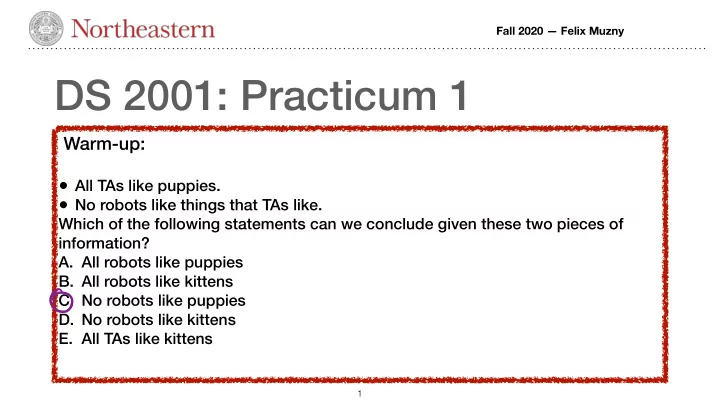

Fall 2020 — Felix Muzny DS 2001: Practicum 1 Warm-up: • All TAs like puppies. • No robots like things that TAs like. Which of the following statements can we conclude given these two pieces of information? A. All robots like puppies B. All robots like kittens 0 C. No robots like puppies D. No robots like kittens E. All TAs like kittens 1
Today's Computing History: The Difference Engine 2
Recall: Running python programs ID IDLE → Atom hello.py python Hello! print("Hello!") interpreter input output (executes the program) $ python hello.py k terminal 3
Values & Data Types Type Examples I -13 int too o -13.3 float 0.72 1.0 " hi " " " " " 12 string cat hat false True boolean 4
Variables 9 € Which of the following statements are true about variable declarations: Jeff 1. the name of the variable always goes on the right side of the "=" sign 2. you can use operators like "+" and "-" but only on the left side of the "=" sign right xty=# NOT , 3. variable names may contain spaces 4. variable names are case insensitive A. 1 & 2 B. 3 C. 4 D. 1, 2, & 4 E. None of the above 5
Variables • We use variables to save values of the results of expressions and functions so that we can use them later (to print, to do further calculations, etc) x = 12 x name = value y = 45 • When we declare a variable with a value, it allocates space in memory to store this value. We can think of the variable as the "name" that it's stored under. - I y t - 6
The print function • The print function is what we use to display any values or information to the user. print(parameters) # print a value • print("hello") ) print 142 # print the value of a variable x = 47 # 42 print(x) var " ) " x string print ( # X print("hello", x) # print multiple values P 7
input function • We say that the input function returns a value (the user's input) • To use this value, we must save it in a variable • All values have a data type, including the return value ① variable = input(prompt) string tix " # name = input("What is your name? ") print("Hello!", name) # string e.g " " 12 print(type(name)) 8
functions - how to call them I return_value = function_name(arguments/parameters) not always included 9
Type Casting • functions that change a value from one type to another • Each basic type has a corresponding function that changes other values to that type. (they return the new value) " " 3 dogs 13J on dogs = input("how many dogs? ") dgE.int ( dogs ) intdogs ) " " 33 # double_dogs = 2 * dogs print("That's so many dogs:", double_dogs) 10
Running python programs Which one of these python program successfully changes ("casts") the integer value stored in the variable x to a string? 130 x = 12 A.x = string(12) print(type(x)) B.str(x) # missing line goes here C.x = "12" - str Cx ) x - O D.x = str(x) # want this to be string print(type(x)) 11
Reading error messages • When you have an error, python will print out an error message. These many *feel* like you've done something wrong, but secretly this is a great thing! I EOLTD End of Line ↳ End of file 12
Reading error messages • When you have an error, python will print out an error message. These many *feel* like you've done something wrong, but secretly this is a great thing! E - - - 13
Work on your practicum - instructions on Canvas • Remote: we're going to put you in break out rooms of 2 - 3 people. • The TAs and myself will be moving between breakout rooms checking in • We recommend turning on your cameras and having one person screen share as you work through the problems • (Remember that you will all individually turn in your assignment though!) • Use the "ask for help" button in zoom if you have a question and there is no TA/Felix in your breakout room. • If your zoom crashes and you need to re-join, you'll be in the main room—we'll keep an eye on this and re-assign you to your breakout room if this happens :) • We'll walk through one of the problems together about 15 minutes before the end. 14
Recommend
More recommend